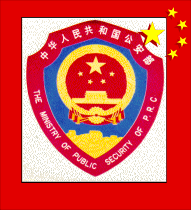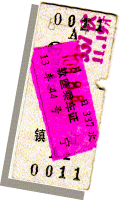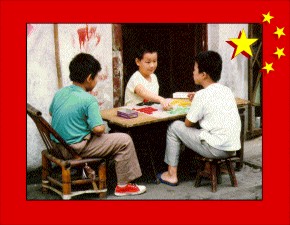

Police of some sorts, including the gong an, zhi an, and bao an seem to be everywhere. Economic police can be seen at state monuments apparently making sure that the state gets its entrance fees from the patrons. The traffic police aid the traffic lights in directing traffic. Traffic police are also assisted at heavy intersections by elderly people who stop bicyclists at the stop lights from proceeding by throwing down a red flag and looking sternly at the anxious bicyclists. We've felt safe travelling throughout China, even on dark alleys at night. One time when we were at the Shanghai train station, Karen noticed a couple of boys who seemed to examining the crowd and luggage for easy prey. They sat near us, attempting to be nondescript as they eyed our things, but we let them know we knew what they were up to and they went in search of other would-be victims. I saw a similar couple of boys in a crowded market area in Beijing as well. Although we constantly felt like taxi drivers were trying to fleece us, the three times we got upset with taxi drivers and a pedicab they either didn't take the fare or tried to return it even though they had taken us some distance each time. |


Official China's approach to traffic can be unique. At busy intersections in Nanjing there are large, digital time clocks counting down the time until the light turns red or green. Despite all the resource spent on traffic, it's still a mess. The law of the road follows this order of dominance: street lights; busses, trucks and cars; "turtles" and other motorized bikes; bikes like the ever popular Phoenix, Forever, Fiverams and Giant(a Taiwanese company!) brand bicycles; and at the bottom-pedestrians but everyone seems to be uncomfortable with the status quo. Busses, taxis, tricycles, and "turtles" (three-wheeled motor cycles or scooters that look like small cars), and motor bikes honk their horns at each other as well as bicyclists and pedestrians even if they are no where near them. Some people seem to honk their horn as if its an expression of their social status. The problem is complex though because many of the bicyclists do get in the way and pedestrians don't seem to respect traffic signals much suggesting that the Chinese are still not comfortably past the era when bicycles reigned supreme.


Our experiences with taxi cabs and one particular pedicab are responsible for a large proportion of our complaints with China. Taxi drivers typically told us they knew where a hotel was even if they didn't. Naturally it wasn't a big concern to them because they were driving with a meter and would get paid by the distance they drover rather than the efficiency with which they got us to a particular location. Several times our taxi driver took us in the most roundabout path to get to a location imaginable. Other times they seemed to get lost, but would never admit it-sometimes until we were further from our goal than when we had entered the taxi.
Sometimes we entered taxis where there are no meters and had to either see if there was a taxi with a meter nearby or bargain with the driver. In Zhengjiang we had to take a taxi ride to a bus station to go on to Yangzhou. The first taxi driver I approached didn't have a meter and he told me he would take us for Y80. When I started to walk away he lowered the price to Y60. The next taxi driver I approached said he would take us for Y40. I got him to agree to take us for Y10 which reflects less my skills as a haggler than the typical taxi driver's thirst for a maximum profit. We arrived a the bus station a few minutes away and then purchased our bus ticket to Yangzhou for Y6. The bus ride was one and a half hours away and included a ferry trip.
After two consecutive frustrating taxi rides in Beijing we hailed a pedicab whose driver took us to a second and third hotel after our first choice was full. Mistakenly believing that this pedicab driver's help may be typical of other experiences with pedicabs and that it was against their interest to take us to the wrong place because the fare is agreed on in advance, we hired another pedicab. We told him where we wanted to go and he said he was familiar with the place. When I began suspecting he was taking us in the wrong direction I tried to tell him and one time even showed him a map which was in Chinese to explain. Each time he laughed as if I was a silly tourist and said "wo zhi dao" (I know [where it is]). When he finally arrived at where he thought we should be going it was about an equal distance in the opposite direction from where we had started to where we needed to go.
On yet another occasion in Beijing, we were taken to a restaurant for which I only had the name in Chinese characters. After the taxi driver dropped us off in the drive-port in front of a building, I looked at the characters on the wall above the glass doors. The characters weren't the same and a taxi driver (from one of the tourist type taxis) approached and I showed him the characters for what we were looking for. He told me he would take me to the place for Y30 explaining that it was very far away, and another driver said he would take me to the place for Y20. An American approached after hearing the discussion and seeing that I was perplexed and informed me that I was where I wanted to be already.
We complained to a Beijing resident about taxi drivers having such creativity with the routes they took and he related that even Chinese people were fleeced when they traveled in parts of China unfamiliar to them. Sometimes our frustration was the result of our misunderstanding the taxi system in Beijing. After a few days in the capitol, we realized that small red taxis and yellow mini-van taxis charged lower fares than the foreign made taxis which were parked in front of tourist motels: yellow mini-vans rates were Y1, red compacts Y1.60, and foreign made 4-doors Y2.
I made a cynical remark above about the cost of a taxi ride for a few minutes relative to a bus ride that was over an hour, but I left out the experience of the bus ride which must be known. No matter what the guidebooks say, there is nothing quite so memorable as riding a ferry across the Chang Jiang (Yangzi River) at dusk in a bus full of Chinese businessmen. Close your eyes and imagine the sensory experience: The air is thick outside, but not so thick as the air inside the bus where many of the businessmen are smoking; the smells that fill this same air are of the smoke being blown in your face and the ferry engine's fuel; and the sound that shares this already cluttered environment is of the ferry engine with talk between the businessmen interrupted intermittently by the sound of the men spitting on the ground between their legs. Alas everything wouldn't be so bad were it not for the thought of the river and the panic which would ensue while you were burned by several cigarettes which probably wouldn't matter since you are sitting in a temporary seat in the center aisle and would probably be drowned by the others trying to escape through the window furthest from them.

Traffic within a city may seem chaotic, but between cities it can be nearly impossible. The standard phrase for a foreign visitor to China is "bu yao" (I don't want [anything]) because pedicab drivers and vendors of souvenirs are constantly approaching, even chasing, tourists with "hello, hello" and persist until they hear "bu yao" a couple of times. On the other hand, when a foreigner tries to approach a ticket office for something other than a jam-packed, filthy-hard seat on a train the standard response is "mei you" ([we] don't have [any]). Every city along a train's route are allocated a specific number of tickets for hard sleepers, soft seats and soft sleepers. There is no communication between the train stations to allocate available seats to the stations that have sold all of theirs, so it may be fairly easy to purchase a ticket in Beijing or Shanghai but next to impossible to do the same in between. Therefore a passenger has to purchase a hard-seat ticket and try to "bu piao" or upgrade once on the train. This can be a pretty scary proposition if you are planning on taking a nine-hour trip and have know idea if there are any hard or soft sleepers available.
There are two other notable distinctions of Chinese train travel: slowness and filth. The trains travel at a very slow speed compared with international standards which is extremely important in China given the fact that rail transport is the principal form of long distance travel in China-planes are notoriously unsafe, they say that even modern imported planes use faulty Chinese reverse engineered, spare parts. Sanitation in China is the worst we have seen in any country. The floor of hard-seat cars are notorious for the trash and spit that accumulates on a journey. The state of the train bathrooms are among the worst we have seen in China. Even the bathrooms at the end of the relatively exclusive soft sleeper, and cleaner, cars look as if they haven't been cleaned for all eternity.

When I had traveled with my wife to the place where she grew up, the Philippines, I anticipated the day when we would go to China where I believed I would be able to communicate and she would be as frustrated with her lack of linguistic ability relative to me as I was with her when she wouldn't explain whole conversations that she was having with her friends. When we traveled to Thailand, South Korea, Tokyo, and through Europe I often thought of what I would say in Chinese if I was in one of the difficult language positions we encountered and thought fairly confidently that I'd survive without too much difficulty. When we arrived in Hong Kong where Cantonese is dominant, I couldn't wait until we got to China where I thought I'd be able to communicate with the Chinese who spoke putong hua. When we arrived in Shanghai I quickly realized that my one-year of Mandarin studies left me with little more than remedial skills. Added to this disappointment was the problem I faced that apparently south of the Chang Jiang, Chinese speakers of putong hua pronounce words different than the way I was taught. They drop the "h" from words with "sh", "zh", and "ch" in pinyin. It was a little easier for me to communicate in Beijing than elsewhere, but as a rule throughout China people would try to draw a character using their forefinger on the palm of the other hand or with a pen and paper to improve our communication. Certainly this habit comes from the experience of Chinese dealing with other Chinese from different regions where the written language is identical, but the spoken language may vary drastically.

It was uncommon to see the sort of shrines which are a common sight in Chinese restaurants around the world in restaurants within China and this as well as the lack of religious practice throughout China due to the state's antagonism to religion.
In Nanjing we visited a Confucian temple and a Buddhist temple. The main room of the Confucian temple was preserved as a diorama of sorts but not of any particular Confucian tradition, instead there were two female figures holding music instruments. The rest of the temple grounds were used as a colorful pebble museum and for shops which sold tourist goods. Atop a hill just inside a portion of the centuries old wall that still surround much of Nanjing was the Jiming Buddhist temple. This temple looked like it had been newly built and I saw a screen depicting the temple grounds with the date of 1991 painted on it. Unlike other temples in Thailand, Korea and Japan, there were very few monks (they were all women so nuns may be the more appropriate term). There were also very few visitors though they did go through ritual practices of lighting candles and incense, as well as bowing before the statue of Buddha with hands together. We were instructed not to take pictures of the Buddhist statues as a point of reverence and we saw hints of a post-Cultural Revolution re-flowering of Buddhism in China. Some parents were instructing their children how to perform ritualistic practices and a couple of young adults seemed to mimic what they had seen others do without fully understanding the significance behind their actions.


 We walked along a portion of the Second Ring Road in Beijing one evening and were surprised by the amount of activity going on even though it was already dark (when we visited China darkness fell shortly after 5:00). There was a man singing in Chinese operatic tradition to the accompaniment of another playing the erhu; there were a couple of dozen women parading-dancing with orange scarves as three simple instruments were being played; there were numerous couples dancing in ballroom style to a certain kind of modern music complete with a multi-colored lighted disco-type ball that rotated in the air; there was a small group performing taiqi; small families going on evening walks; young couples exploring each other; portable bicycle repair shops (from bicycles themselves) at an odd corner; staple and prepared food markets; a group playing badminton; small groups of men playing cards or Chinese checkers; and ubiquitous bicycle riders which always outnumber the cars on the street.
We walked along a portion of the Second Ring Road in Beijing one evening and were surprised by the amount of activity going on even though it was already dark (when we visited China darkness fell shortly after 5:00). There was a man singing in Chinese operatic tradition to the accompaniment of another playing the erhu; there were a couple of dozen women parading-dancing with orange scarves as three simple instruments were being played; there were numerous couples dancing in ballroom style to a certain kind of modern music complete with a multi-colored lighted disco-type ball that rotated in the air; there was a small group performing taiqi; small families going on evening walks; young couples exploring each other; portable bicycle repair shops (from bicycles themselves) at an odd corner; staple and prepared food markets; a group playing badminton; small groups of men playing cards or Chinese checkers; and ubiquitous bicycle riders which always outnumber the cars on the street.

